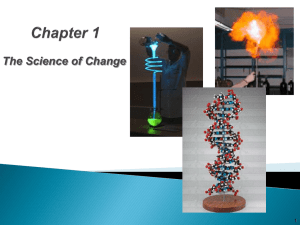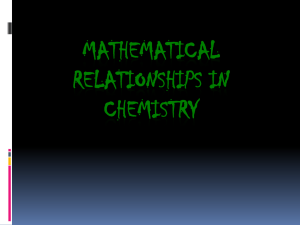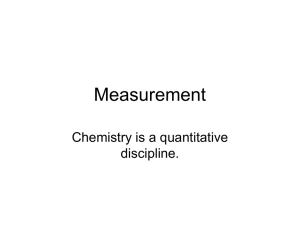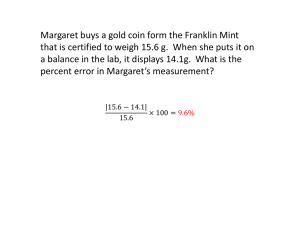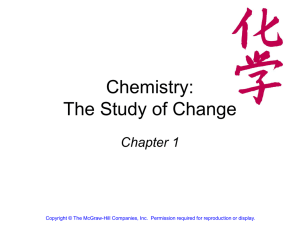Ch.3 - Measurement
advertisement
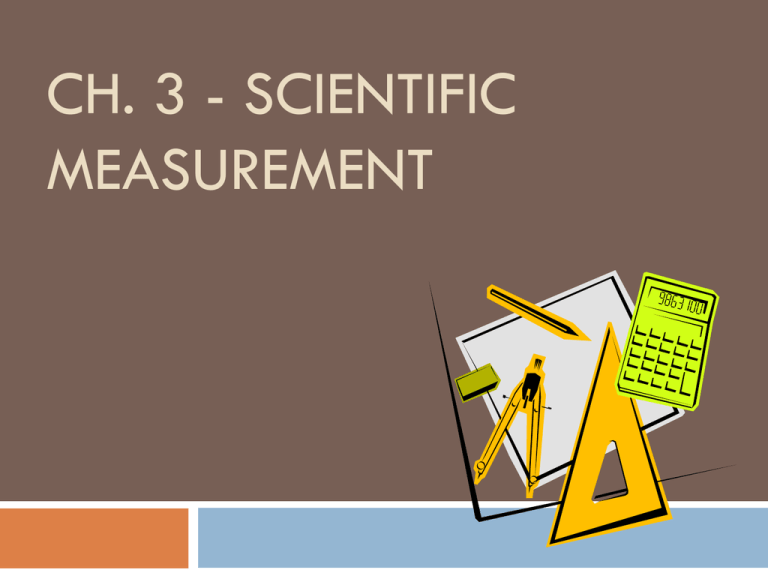
CH. 3 - SCIENTIFIC MEASUREMENT 3.1 Using and Expressing Measurements In scientific notation, a given number is written as the product of two numbers: a coefficient and 10 raised to a power. The number of stars in a galaxy is an example of an estimate that should be expressed in scientific notation. Did You Know? The mass of an electron is 0.000000000000000000000000000911 g The mass of the sun is about 2000000000000000000000000000000000 g Scientific Notation STOP Only one digit 3.23 x 4 10 “+” or “-” integer tells you how many places to move the decimal Scientific Notation Move Ie. Move Ie. decimal point to the right if # is small 0.00605 m = 6.05 x 10-3 m decimal point to the left if # is large 45,000 g = 4.5 x 104 g Examples 654000 = 6.54 x 105 -3 = 4.56 x 10 .00456 1.23 x 104 = 12,300 3.45 x 10-6 = 0.00000345 Practice Problem A Convert 0.002001 to scientific notation 2.001 x -3 10 Practice Problem B Convert 9.10 x 102 to long form 910 Using Your Calculator… If you use a… T.I. use the “EE” button Casio use the “Exp” button Try these now… (3.9 x 107) x (1.2 x 103) Practice Problem C Calculate: (8.5 x 10-3) - (3.1 x 10-3) Practice Problem D Calculate: (8.4 x 10-3) / (4.7 x 104) Precision - is a measure of how close a series of measurements are to one another Accuracy closeness of a measurement to the true or actual value of whatever is measured 3.1 To evaluate the accuracy of a measurement, the measured value must be compared to the correct value. To evaluate the precision of a measurement, you must compare the values of two or more repeated measurements. 3.1 Determining Error The accepted value is the correct value based on reliable references. The experimental value is the value measured in the lab. The difference between the experimental value and the accepted value is called the error. Percent Error error = actual value - experimental value Percent error = | error | actual value x 100% If you estimate that there are 90 jelly beans in a jar when there is actually 120, your percent error is… | 90-120 | x 100% = 25 % error 120 Practice Problem E A student estimated the volume of a liquid in a beaker as 200 mL. When she poured the liquid into a graduated cylinder, she measured 208 mL. Calculate the percent % error. 3.1 Significant Figures in Measurements Measurements must always be reported to the correct number of significant figures because calculated answers often depend on the number of significant figures in the values used in the calculation.They also convey the degree of accuracy of the measuring device. 3.1 Significant Figures in Measurements Suppose you estimate a weight that is between 2.4 lb and 2.5 lb to be 2.46 lb. The first two digits (2 and 4) are known. The last digit (6) is an estimate and involves some uncertainty. All three digits convey useful information, however, and are called significant figures. The significant figures in a measurement include all of the digits that are known, plus a last digit that is estimated. Measuring devices have differing degrees of accuracy ignificant Figures certain digits 6.34 mL 7.00 uncertain digit ( 0.01 mL) 3 significant digits 6.00 Significant Figure’s Rules 1) Every nonzero digit is significant 2) Leading zeros are never significant 3) Trailing zeros are significant only after a decimal point (to the right) 4) Zeros between significant digits are significant Sig.Fig. Examples Sig Figs Scientific Notation 3 2.40 x 10-1 g 0.0034 L 2 3.4 x 10-3 L 24.010 m 5 2.4010 x 101 m 1250 cm3 3 1.25 x 103 cm3 0.240 g Sig Figs Calculations • exact numbers: definitions & whole numbers (unlimited # of sig.figs.) 12 in/ft 100 cm/m 10 soccer players 2.54 cm/in 2 atoms of O in CO2 Practice Problem F Round measurements to 3 sig figs 98.473 L A. B. C. 98.4 L 98.5 L 98.0 L Practice Problem G Round measurements to 3 sig figs 57.048 m A. B. C. 57.0 m 57.04 m 57.1 m Practice Problem H Round each of these measurements to 3 sig figs 1764.9 mL A. B. C. 1765 mL 176 mL 1760 mL Sig.Figs. Calculations multiplication & division: answer should have the same # of significant figures as the least # of sig figs Examples: 9.183 x 1.25 = 11.5 (3 sig.figs.) 2.9 / 21.739 = 0.13 (2 sig.figs.) Practice Problem I Correctly round the answer 4.32 cm x 1.7 cm = 7.344 cm2 Sig.Figs. Calculations addition & subtraction: answer should have the same # of decimal places as the least # of decimal places Examples: 4.02 - 3.956 = 0.06 (2 dec.places) 9.89 + 100 = 110 (0 dec.places) Practice Problem J Correctly round the answer 853.20 L - 627.443 L = 225.757 L INTERNATIONAL SYSTEM OF UNITS SECTION 3.2 S.I. Metric System Easy to use because it is based on the number 10 Units of Measurement Length - meters, m Mass - grams, g Volume - liters, L Time - seconds, s Temperature - celcius, oC Amount of substance - moles, mol Volume For liquids, use a graduated cylinder Measured in liters (L) Milliliters are more common (mL) For solids, use math Measured in cubic centimeters (cm3) V = l · w · h cm3 h l w Important Conversions for Volume 1 3 cm = 1 mL & 1 dm3 = 1 L 3.2 Units and Quantities sugar cube has a volume of 1 cm3. 1 mL is the same as 1 cm3. A 3.2 A gallon of milk has about twice the volume of a 2-L bottle of soda. Prefix Symbol MegaKiloHectoDeka- M k h dk SI Unit d c m µ n p Base Unit DeciCentiMilliMicroNanoPico- 3 spaces 3 spaces 3 spaces 3 spaces Practice Problem K What is the correct SI unit for temperature? A. B. C. D. Kelvin Fahrenheit Celsius None of the Above Practice problem L Convert: 250 mL = _____ cm3 3.2 Common metric units of mass include gram, milligram, and microgram. kilogram, Practice Problem M Convert: 2.0 x 101 kg = _____ g Practice Problem N Convert: 75 mm = _____ km Practice Problem N Convert: 99 nm = _____ pm Temperature Measures the average kinetic energy of matter Determines the direction of the heat transfer From high temp. to low temp. 3 temp. scales Fahrenheit Celcius Kelvin (or absolute) 3.2 Units of Temperature Temperature is a measure of how hot or cold an object is. Thermometers are used to measure temperature. Scientists commonly use two equivalent units, degree Celsius and Kelvin 3.2 On the Celsius scale, the freezing point of water is 0°C and the boiling point is 100°C. On the Kelvin scale, the freezing point of water is 273.15 kelvins (K), and the boiling point is 373.15 K. The zero point on the Kelvin scale, 0 K, or absolute zero, is equal to 273.15 °C. 3.2 Because one degree on the Celsius scale is equivalent to one kelvin on the Kelvin scale, converting from one temperature to another is easy. You simply add or subtract 273, as shown in the following equations. Temperature Conversions K = °C + 273 °C = K - 273 °C =(°F - 32)/1.8 °F = (1.8x°C) + 32 Practice Exercises Normal human body temperature is 37 °C . What is That temperature in kelvins? K = °C + 273 K = 37 + 273 K = 310 Surgical instruments may be sterilized by heating at 443 K for 1.5 hours. Convert kelvins to °C. °C = K - 273 °C = 443 - 273 °C = 170 Practice Problem Average temperature of Colorado in October is 18.3°C. What is this in °F? 3.3 Conversion Factors Section 3.3 Conversion Factors What happens when a measurement is multiplied by a conversion factor? 3.3 A conversion factor is a ratio of equivalent measurements. The ratios 100 cm/1 m and 1 m/100 cm are examples of conversion factors. 3.3 ***Remember*** When a measurement is multiplied by a conversion factor, the numerical value is generally changed, but the actual size of the quantity measured remains the same. 3.3 The scale of the micrograph is in nanometers. Using the relationship 109 nm = 1 m, you can write the following conversion factors. 3.3 Dimensional Analysis Dimensional analysis is a way to analyze and solve problems using the units, or dimensions, of the measurements. Dimensional analysis provides you with an alternative approach to problem solving. Practice Problem Practice Problem Practice Problem 3.3 Converting Complex Units Many common measurements are expressed as a ratio of two units. If you use dimensional analysis, converting these complex units is just as easy as converting single units. It will just take multiple steps to arrive at an answer. Practice Problem Section 3.4 Density is mass per unit volume D = mass / volume The higher the density the more “stuff” is packed together 3.4 Determining Density Density is an intensive property that depends only on the composition of a substance, not on the size of the sample. If the density of an object is less than the density of the fluid it is in, it will float in that fluid. Ex. Oil and Water = the oil floats Rock and Water = the rock sinks Practice Exercises A piece of silver jewelry has a mass of 8.37 g. If the density of silver is 10.5 g/cm3, what is the volume of the piece of jewelry? V=M/D V = 8.37 g / 10.5 g/cm3 V = 0.797 cm3 Peanut oil has a density of 0.92 g/cm3. If a recipe calls for 237 mL of peanut oil, what mass are you using? M=VxD M = 237 mL x 0.92 g/cm3 M = 220 g Practice Problem Calculate the volume of a gas that has the measurements of 25 g and 2.0 g/mL Specific Gravity The ratio of the density of a substance to the density of water (1 g/cm3) Measured with a hydrometer No units Specific Gravity Example: Material Gold Density @ 20 oC 19.3 g/cm3 Aluminum 2.70 g/cm3 Corn Oil 0.922 g/cm3 Specific Gravity 19.3 2.70 0.922


